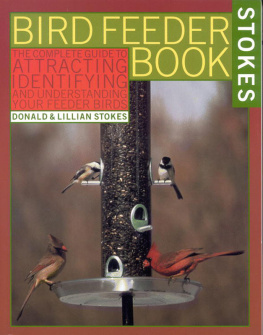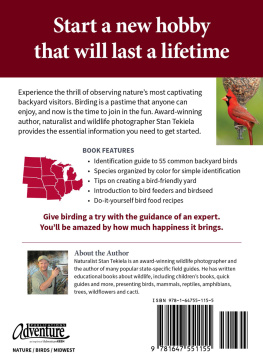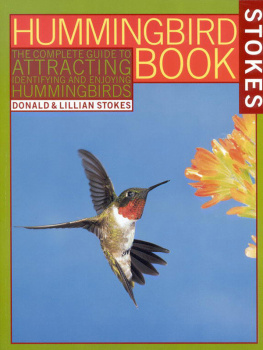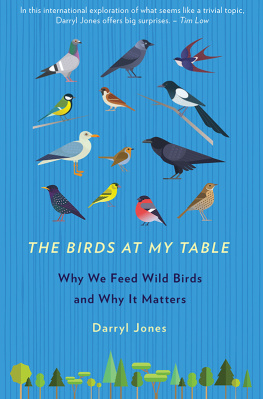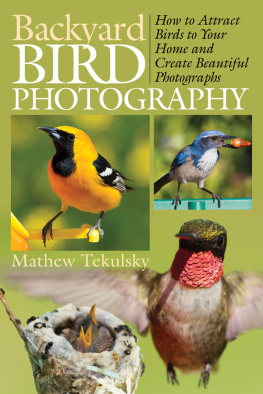COPYRIGHT 1987 BY DONALD W. STOKES AND LILLIAN Q. STOKES
ALL RIGHTS RESERVED. EXCEPT AS PERMITTED UNDER THE U.S. COPYRIGHT ACT OF 1976, NO PART OF THIS PUBLICATION MAY BE REPRODUCED, DISTRIBUTED, OR TRANSMITTED IN ANY FROM OR BY ANY MEANS, OR STORED IN A DATABASE OR RE TRIEVAL SYSTEM, WITHOUT THE PRIOR WRITTEN PERMISSION OF THE PUBLISHER.
Little, Brown and Company
Hachette Book Group
237 Park Avenue, New York, NY 10017
Visit our Web site at www.HachetteBookGroupUSA.com
First eBook Edition: November 2008
The Little, Brown and Company name and logo is a trademark of Hachette book Group
ISBN: 978-0-316-04956-6
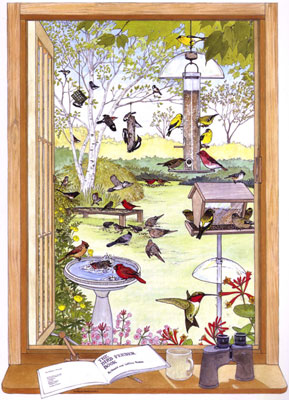
Stokes Field Guides
Stokes Field Guide to Birds: Eastern Region
Stokes Field Guide to Birds: Western Region
Stokes Field Guide to Bird Songs: Eastern Region (CD/cassette)
Stokes Field Guide to Bird Songs: Western Region (CD/cassette)
Stokes Field Guide to Warblers
Stokes Beginners Guides
Stokes Beginners Guide to Bats
Stokes Beginners Guide to Bird Feeding
Stokes Beginners Guide to Birds: Eastern Region
Stokes Beginners Guide to Birds: Western Region
Stokes Beginners Guide to Butterflies
Stokes Beginners Guide to Dragonflies
Stokes Beginners Guide to Hummingbirds
Stokes Beginners Guide to Shorebirds
Stokes Backyard Nature Books
Stokes Bird Feeder Book
Stokes Bird Gardening Book
Stokes Birdhouse Book
Stokes Bluebird Book
Stokes Butterfly Book
Stokes Hummingbird Book
Stokes Oriole Book
Stokes Purple Martin Book
Stokes Wildflower Book: East of the Rockies
Stokes Wildflower Book: From the Rockies West
Stokes Nature Guides
Stokes Guide to Amphibians and Reptiles
Stokes Guide to Animal Tracking and Behavior
Stokes Guide to Bird Behavior, Volume 1
Stokes Guide to Bird Behavior, Volume 2
Stokes Guide to Bird Behavior, Volume 3
Stokes Guide to Enjoying Wildflowers
Stokes Guide to Nature in Winter
Stokes Guide to Observing Insect Lives
Other Stokes Books
The Natural History of Wild Shrubs and Vines
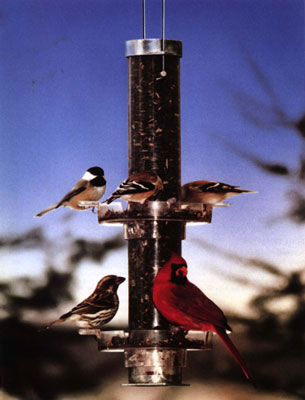
The joy of attracting birds is open to everyone and is remarkably easy if certain basic guidelines are followed. Birds need food, water, shelter from predators, and places to raise their young. Provide birds with the foods they love and with the kinds of flowers, shrubs, and trees that create an attractive habitat, and wild birds will flock to your property.
Over the years we have had success in attracting more than one hundred species of birds to our yard and have had more than forty species nest there. In the following pages we share our recommendations on how to meet the needs of birds in some of the best and easiest ways.
The most important factor in setting up a successful feeding station, is to offer a variety of foods and to place each in the proper setting. Through years of experience and research, we have found that a good all-around feeding program which will attract the most birds throughout the year must include at least four things:
1. A hanging feeder with sunflower seed
2. A ground or tray-type feeder with cracked corn and mixed seed
3. Suet feeder
4. Water
On the next few pages are detailed descriptions of each type of feeder and suggestions on how to make them even more attractive to birds.
Tube feeder with sunflower seed; male cardinal, black-capped chickadee, American goldfinches, and female purple finch are enjoying a meal.
Description: A hanging or pole-mounted feeder that contains only sunflower seed, desirable because sunflower seed is the number-one choice of most songbirds.
Birds Attracted to Sunflower Feeders: Black-capped chickadee, Carolina chickadee, tufted titmouse, white-breasted nuthatch, red-breasted nuthatch, cardinal, American goldfinch, purple finch, house finch, pine siskin, downy woodpecker, hairy woodpecker, red-bellied woodpecker, red-headed woodpecker, common flicker, evening gros-beak, starling, house sparrow, blue jay, scrub jay.
Placement of Feeder: If you are just starting, place the feeder away from the house in an area that you can see but that is also near trees or shrubs visited by birds. Birds feel safer and are less hesitant to come to a feeder if vegetation is nearby. Once they are used to the feeder, you can gradually try moveing it closer to your house for better viewing. Put it near the windows you look out of most often. You want to be sure not to miss any exciting behavior, and you will be amazed at how much is happening once you start looking.
You can hang the feeder from a tree, mount it on a pole, or hang it from a wire strung between two supports. You must use baffles on the feeder to keep away squirrels. See the chapter Dealing with Squirrels, p. 12.
How soon the birds discover and start using your feeder depends on many things, such as where you live, whether there is a good bird population in your area, and whether some of the birds are already familiar with feeders. Be patient and they will soon arrive.
Types of Sunflower Seed: There are three kinds of sunflower seed available, distinguished by size and the pattern on their hulls. Gray-striped seed is the largest; next is the medium-sized black-striped sunflower; and the smallest is black oil sunflower, which has all-black hulls. All of these are very popular with birds, but a recent study by Dr. Aelred Geis of the U.S. Fish and Wildlife Service showed that the black oil sunflower is the preferred type of most seed-eating birds. It has a thinner shell that is easier for small birds to remove and has a higher percentage of oil for its weight.
Sunflower seed is also available with the shells already removed; this is called hulled sunflower or sunflower hearts. It is somewhat more expensive than the unhulled varieties, but it is highly attractive to many species of birds, including woodpeckers. Dr. Geiss study found that it is the number-one choice of the American goldfinch, even preferred over thistle (niger) seed. An added advantage is that there are no empty hulls to clean up under the feeder.
CHOOSING A SUNFLOWER FEEDER
If you walk into any store with bird feeders, you will be greeted with a bewildering array of choices. This section will help you choose the best ones. We recommend that you invest your money in a well-made feeder in the beginning, for it will last a long time and will reward you with years of enjoyment.
Here are some overall features to consider when buying any bird feeder:
It should be easy to fill
It should hold lots of seed so you dont have to fill it as often
It should be easy to take apart and clean
Clear parts should be plastic and not glass (preferably Lexan brand plastic, which is unbreakable and cannot be chewed by squirrels)
It should protect the seed from rain and snow
It should have metal perches and reinforced openings if it is a tube feeder, so squirrels cannot chew them
It should have a manufacturers guarantee if possible

